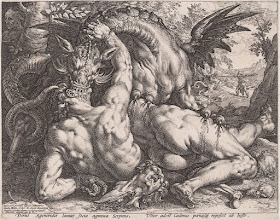Beautiful Monsters in Early European Prints and Drawings (1450–1700) presents nearly 70 rarely exhibited prints and drawings by 45 artists selected from the National Gallery of Canada collection, including a number of recent acquisitions and promised gifts. Springing from the imagination of artists such as German painter and printmaker Albrecht Dürer (1471–1528) and fed by the collective fears of the Renaissance and Baroque periods, these images were produced using a variety of techniques including etching, engraving, woodcut and drawing.
"By looking at these works from the Gallery's collection closely, one can see all the talent and ingenuity Renaissance and Baroque artists devoted to creating creatures that are both monstrous and refined," said Sonia Del Re, PhD (Art History), exhibition curator and Senior Curator of Prints and Drawings at the National Gallery of Canada. "Visitors of all ages will be fascinated by these beasts from a bygone era that continue to fuel the imaginations of dreamers and creators today."
Beautiful Monsters in Early European Prints and Drawings (1450–1700) is divided into four themes:
- Demons presents illustrations of biblical stories and accounts of the lives of saints. The works include a remarkable miniature drawing on vellum by Flemish artist Johan Wierix (1549–1620) titled Frontispiece to "The Creation and Early History of Man," c. 1606, which was donated to the Gallery in 2019 by Frank and Marianne Seger.
- Mythological Creatures brings together images that illustrate Greco-Roman myths, often involving hybrid creatures that are half-human, half-animal. This section features The Dragon Devouring the Companions of Cadmus, a work by the famous Dutch engraver Hendrick Goltzius (1558–1617), which the Gallery acquired earlier this year. This masterpiece, a collaboration between the engraver and the painter Cornelis van Haarlem (1562–1638), was produced in 1588 based on a painting by van Haarlem, now in the collection of The National Gallery, London.
- Sea Monsters features dangerous beasts emerging from the depths of the ocean and includes one of the most celebrated images in the history of printmaking: Battle of the Sea Gods (1485) by Italian artist Andrea Mantegna (1431–1506).
- Ornamental Beasts comprises, among other works, small-scale models for decorating utilitarian objects such as silverware, armour and ceramics with fanciful figures.
The exhibition Beautiful Monsters in Early European Prints and Drawings (1450–1700) is complemented by programming for all ages.
Monstrous Activities
Two fun activities have been incorporated into this exhibition: a monster scavenger hunt, an activity sheet available in the space that invites visitors to find 8 monsters in the artworks on display, which they can then take home and colour; and "Monster Mash" activity, which encourages visitors to create their own hybrid monsters on two magnetic walls.Meet the Expert: Sonia Del Re
Thursday, December 12 at 6:00 p.m., exhibition curator Sonia Del Re will explain why fantastic creatures appear in so many Renaissance drawings and prints. In Gallery C218. In English with a bilingual question period. Free admission.Concert
Saturday, January 25, 2020, at 2:00 p.m., Ottawa storyteller and comedian David Brennan will bring to life the myths and legends of the fantastic creatures in the exhibition. His performance will be accompanied by the music of the Ottawa Baroque Consort. In the Auditorium.
SOURCE: National Gallery of Canada


